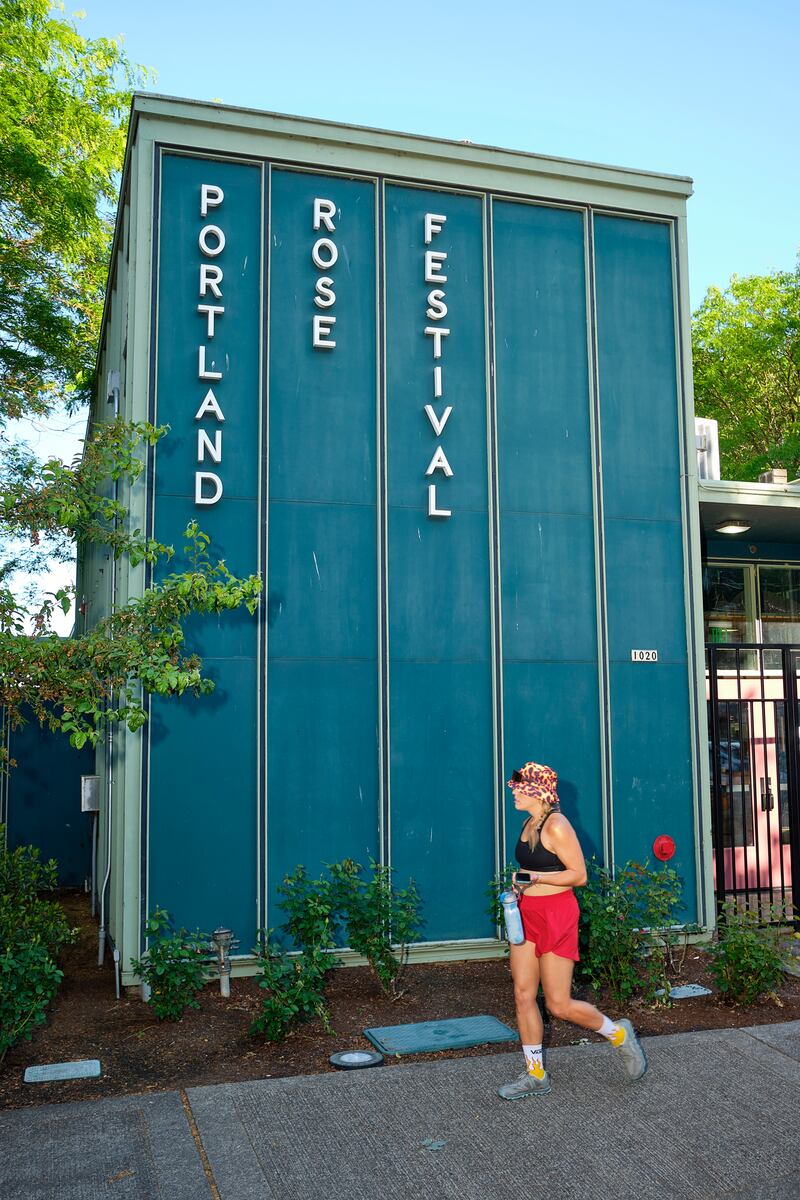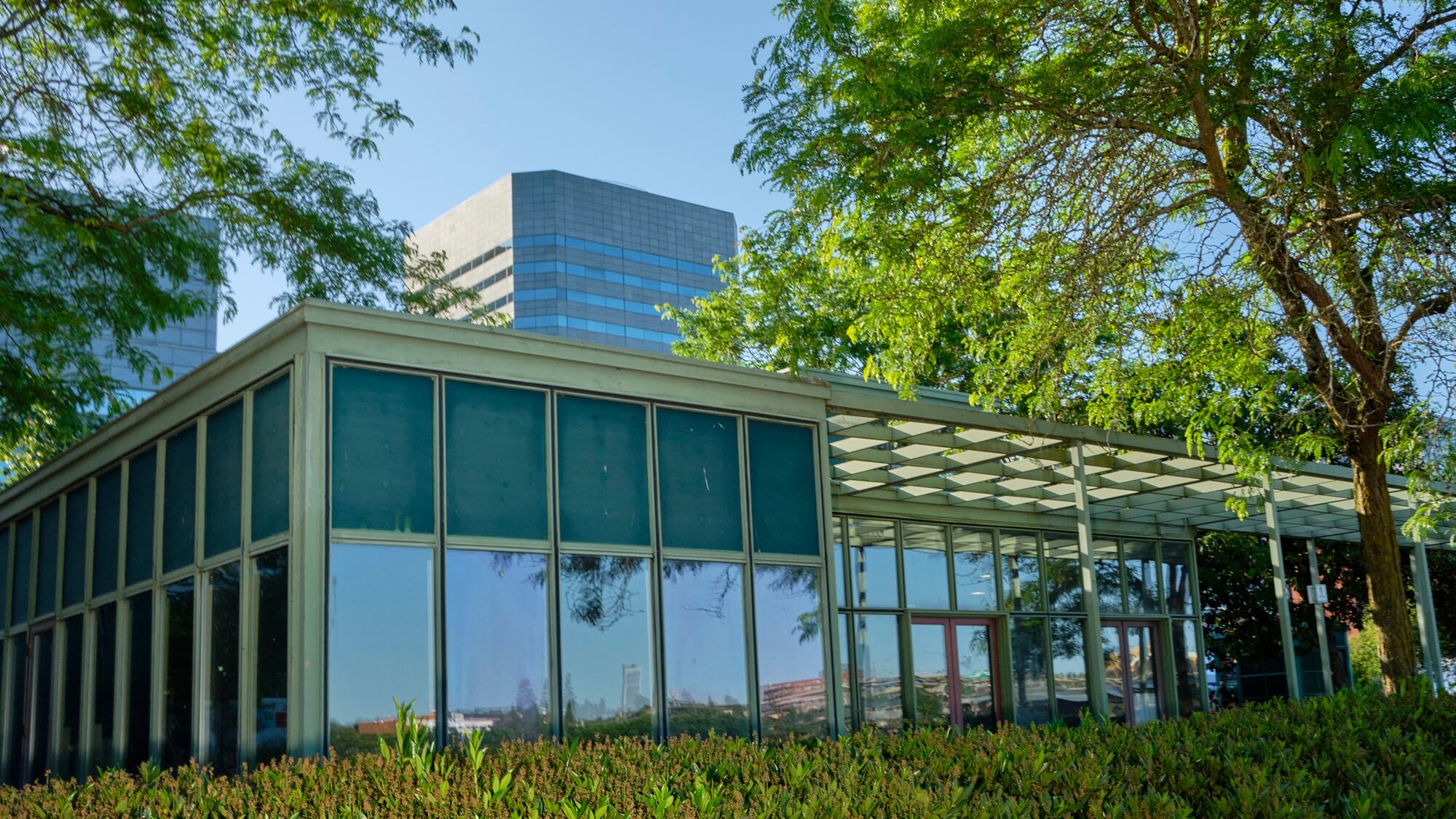ADDRESS: 1020 SW Naito Parkway
YEARS BUILT: 1949
SQUARE FOOTAGE: 3,843
MARKET VALUE: $4.32 million
OWNER: The city of Portland
HOW LONG IT’S BEEN EMPTY: It’s not.
WHY IT’S EMPTY: COVID and reassessments
Legendary Portland architect John Yeon wanted the Rose Building to be a visitor’s introduction to Portland. In a way, it is.
Built in 1949 from Yeon’s design as a visitor information center, the building occupies a singular position as the only office or commercial space in Tom McCall Waterfront Park. It’s located just north of the Hawthorne Bridge.
When it opened, the building’s surroundings were very different. It stood next to Harbor Drive, an expressway that preceded the park, and the hulking headquarters of Portland’s afternoon daily newspaper, The Oregon Journal.
Both the expressway and the Journal building are long gone. But Yeon’s creation remains, repurposed as the headquarters of the Portland Rose Festival and somewhat worse for wear. Yeon’s native plantings are gone and the lily pond is dry. Blackened squares of aluminum foil, the detritus of fentanyl use, blow against the building’s exterior like autumn leaves.
There is little to no public interaction with the structure, which serves as an office to eight Rose Festival Foundation staffers, who are there regularly but occupy little space in the nearly 4,000-square-foot building. Our weekly column Chasing Ghosts typically examines a vacant property. The Rose Building is occupied—it’s just hard to tell.
That such an iconic property is consigned to desks for a festival that runs just three weekends a year is a reminder of Portland’s stubborn reluctance to enliven its waterfront, even as Vancouver, Wash., has followed San Antonio, Austin, Toronto and many other cities in developing amenities around waterways.
Ethan Seltzer, an emeritus professor of urban studies and planning at Portland State University, regularly rides his bike past the building. He notes that it’s adjacent to one of the park’s most visited features—Salmon Street Springs—and wonders if part of the building could be more engaging to visitors.
“If such a prominent public property is going to be used for private activity, what does the public have a right to expect?” Seltzer asks. “Maybe there’s a 365-day use, such as some version of a visitor center, that could do more.”
Portland writer Randy Gragg, the former executive director of the University of Oregon’s John Yeon Center for Architecture and the Landscape, charted the building’s history in a 2017 book he edited, John Yeon Architecture: Building in the Pacific Northwest.
In its day, Gragg notes, the building won national acclaim, its Northwest style combining glass and local wood products to capitalize on its riverside location. But the accolades faded. The building leaked. The Men’s Garden Club ripped out native plantings and replaced them with “exotic roses.”
“The later history of the Visitors Center is an unfortunate chapter in the region’s stewardship of architecture,” Gragg wrote.

The city of Portland took it over from the chamber of commerce and, in the 1970s, leased it to a restaurant named McCall’s. Yeon himself argued that it should instead be torn down because the space wouldn’t work as a restaurant (it didn’t, despite offering $4 appletinis) and he feared the intrusion of commerce into a city park.
The building limped along until 2010, when two city commissioners, Nick Fish, who ran Portland Parks & Recreation, and Randy Leonard, who ran the Water Bureau, worked out a swap: Parks turned the moribund structure over to the Water Bureau, which used ratepayer money to refurbish it and turn it over to the Rose Festival on a 25-year lease—$1 a month for rent and $667 for improvements. (A recent audit values the lease at about $2.6 million.)
The rehab coincided with a successful petition to place the building on the National Register of Historic Places.
The sweetheart lease later became a focal point of a ratepayer lawsuit that argued the Portland Water Bureau had misspent public funds. The city paid back some of the money (read an interview with Leonard on page 20). But the Rose Festival staff remains ensconced in the building, planning and organizing for the following year’s festival, while keeping watch on the one at hand.
Longtime Rose Festival spokesman Rich Jarvis says being located right where the organization hosts the city’s annual shindig is better than previous locations on Southwest Macadam Avenue and under a parking garage on Southwest Market Street.
It’s also never dull. “We’ve had some break-ins and we’ve made some friends with people who live along the river,” Jarvis says. “The view is wonderful, though. You can’t beat that.”
Every week, WW examines one mysteriously vacant property in the city of Portland, explains why it’s empty, and considers what might arrive there next. Send addresses to newstips@wweek.com.

